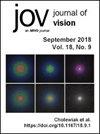贡献讲座三:脉冲序列到感知:一个虚拟病人描述人类视觉皮层刺激的感知效应。
IF 2.3
4区 心理学
Q2 OPHTHALMOLOGY
引用次数: 0
摘要
在这里,我们描述了基于V1神经生理结构的计算模型或“虚拟患者”如何用于预测皮质植入患者的感知体验。我们的虚拟患者模型可以成功地描述来自先前发表的广泛研究的心理物理数据,这些研究描述了人类电诱导感知的位置、大小、亮度和时空形状。我们的模拟表明,在可预见的未来,皮质假肢装置的感知质量很可能受到视觉皮层的神经生理组织的限制,而不是电极的大小和间距。本文章由计算机程序翻译,如有差异,请以英文原文为准。
Contributed Talks III: Pulse trains to percepts: A virtual patient describing the perceptual effects of human visual cortical stimulation.
Here we describe how computational models or 'virtual patients', based on the neurophysiological architecture of V1, can be used to predict the perceptual experience of cortical implant patients. Our virtual patient model can successfully describe psychophysical data from a wide range of previously published studies describing the location, size, brightness and spatiotemporal shape of electrically induced percepts in humans. Our simulations suggest that, in the foreseeable future, the perceptual quality of cortical prosthetic devices is likely to be limited by the neurophysiological organization of the visual cortex, rather than the size and spacing of electrodes.
求助全文
通过发布文献求助,成功后即可免费获取论文全文。
去求助
来源期刊

Journal of Vision
医学-眼科学
CiteScore
2.90
自引率
5.60%
发文量
218
审稿时长
3-6 weeks
期刊介绍:
Exploring all aspects of biological visual function, including spatial vision, perception,
low vision, color vision and more, spanning the fields of neuroscience, psychology and psychophysics.
 求助内容:
求助内容: 应助结果提醒方式:
应助结果提醒方式:


